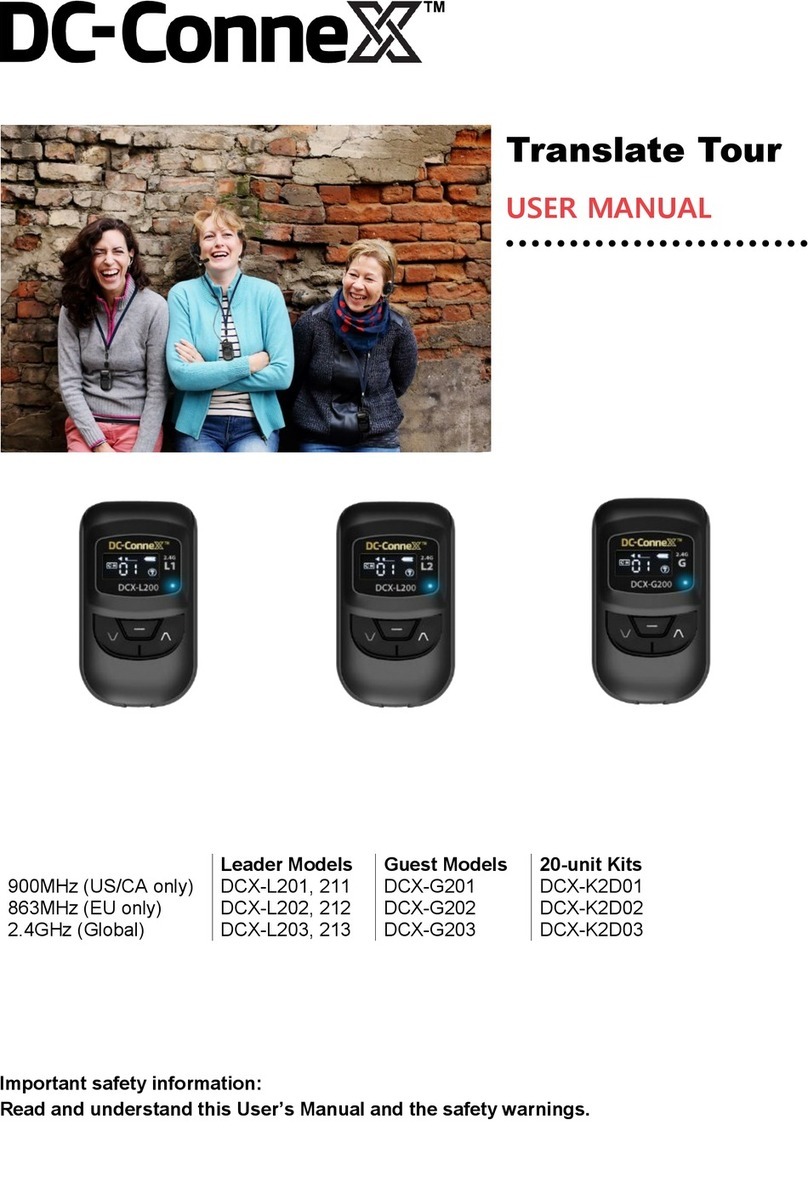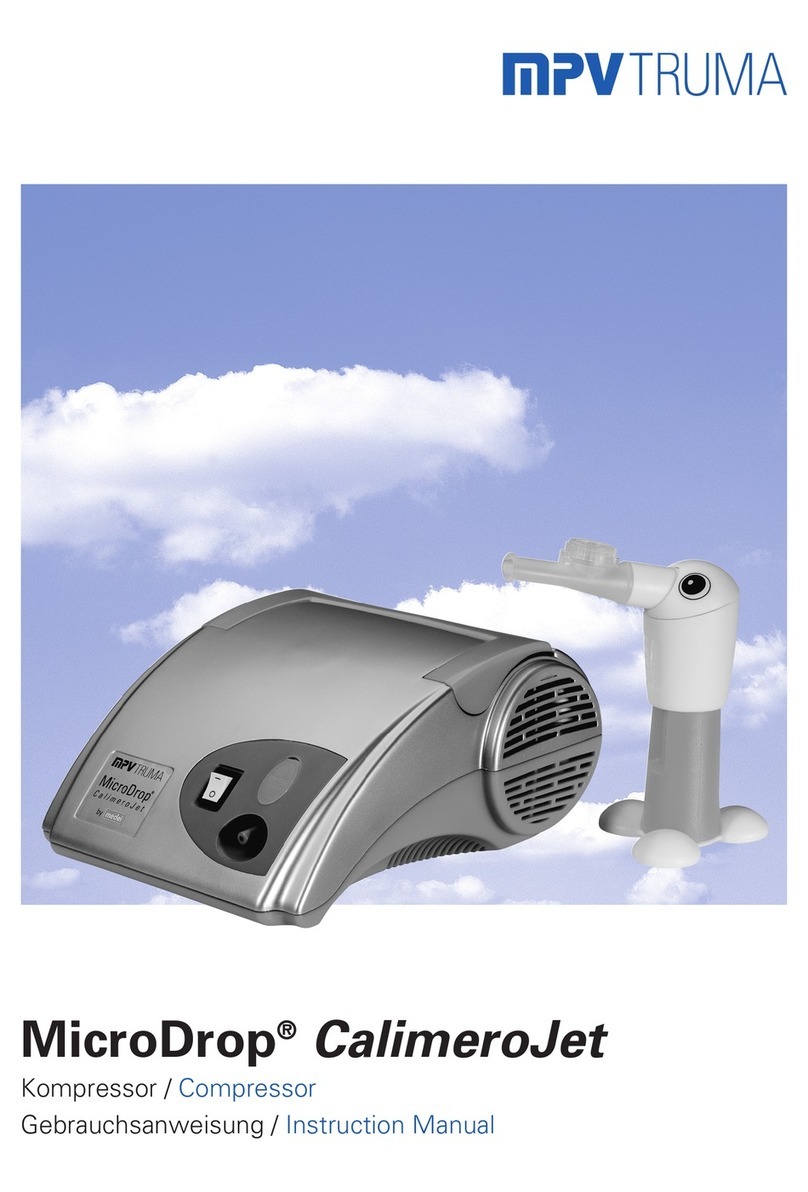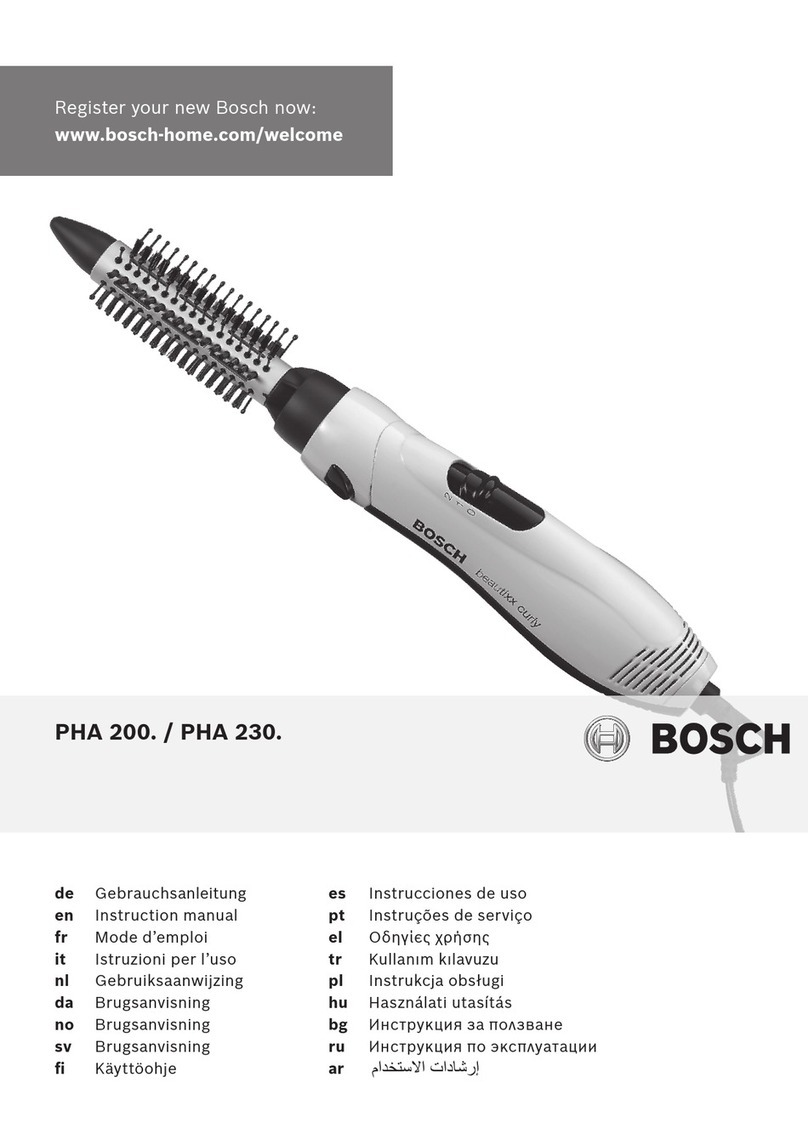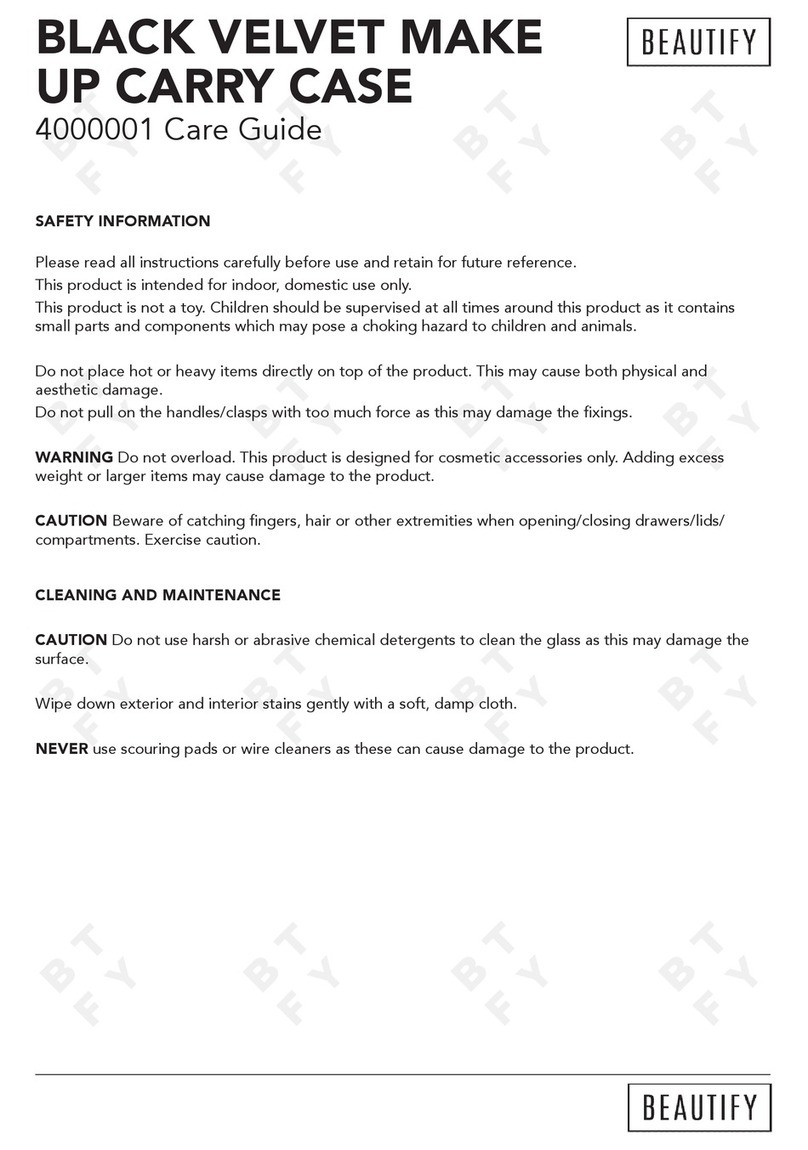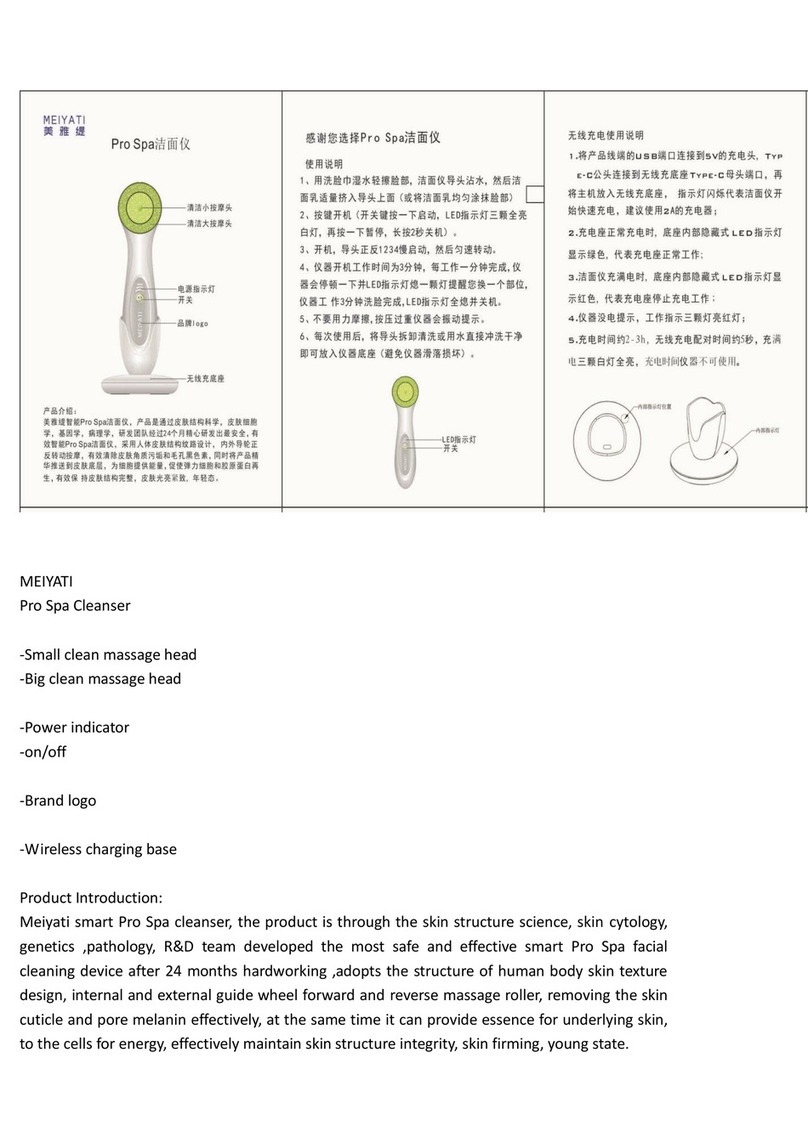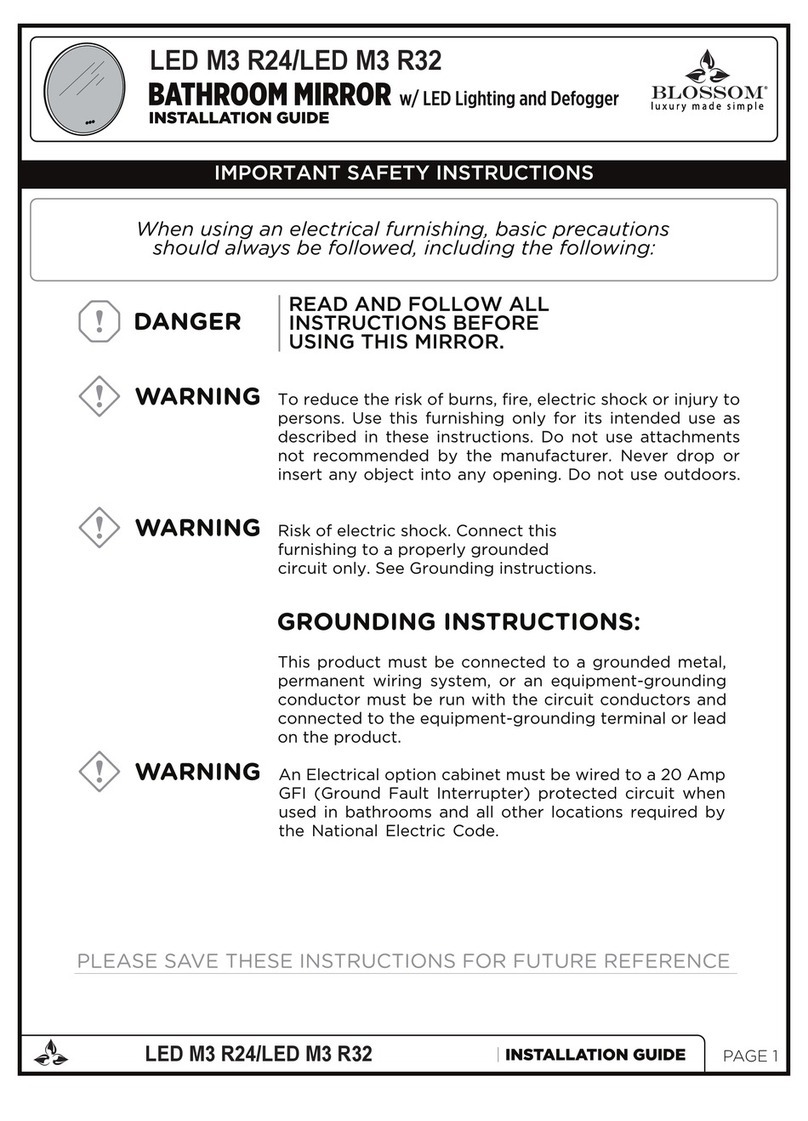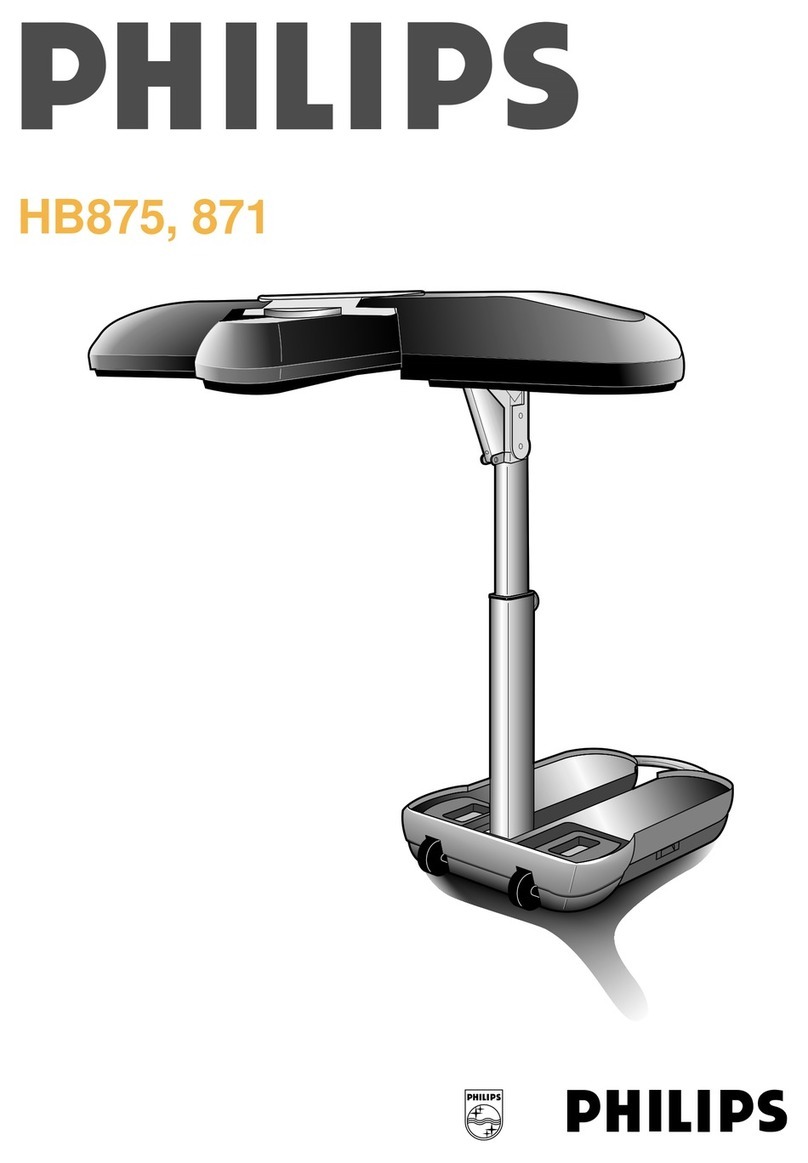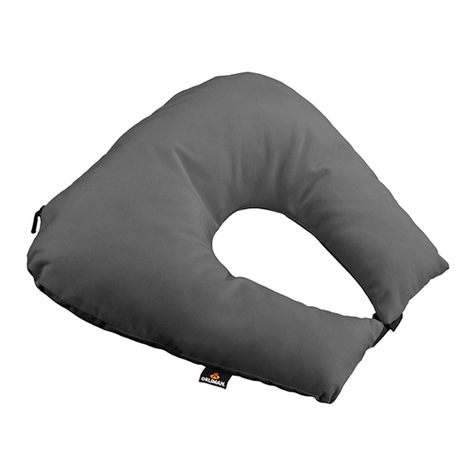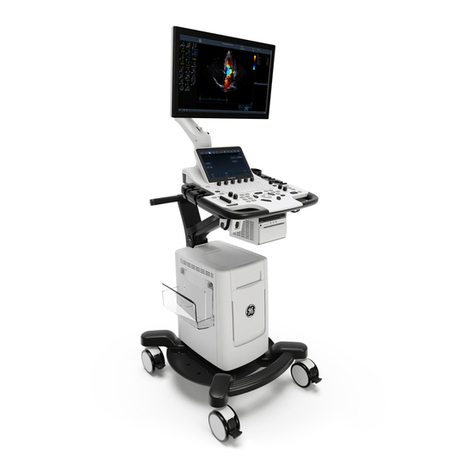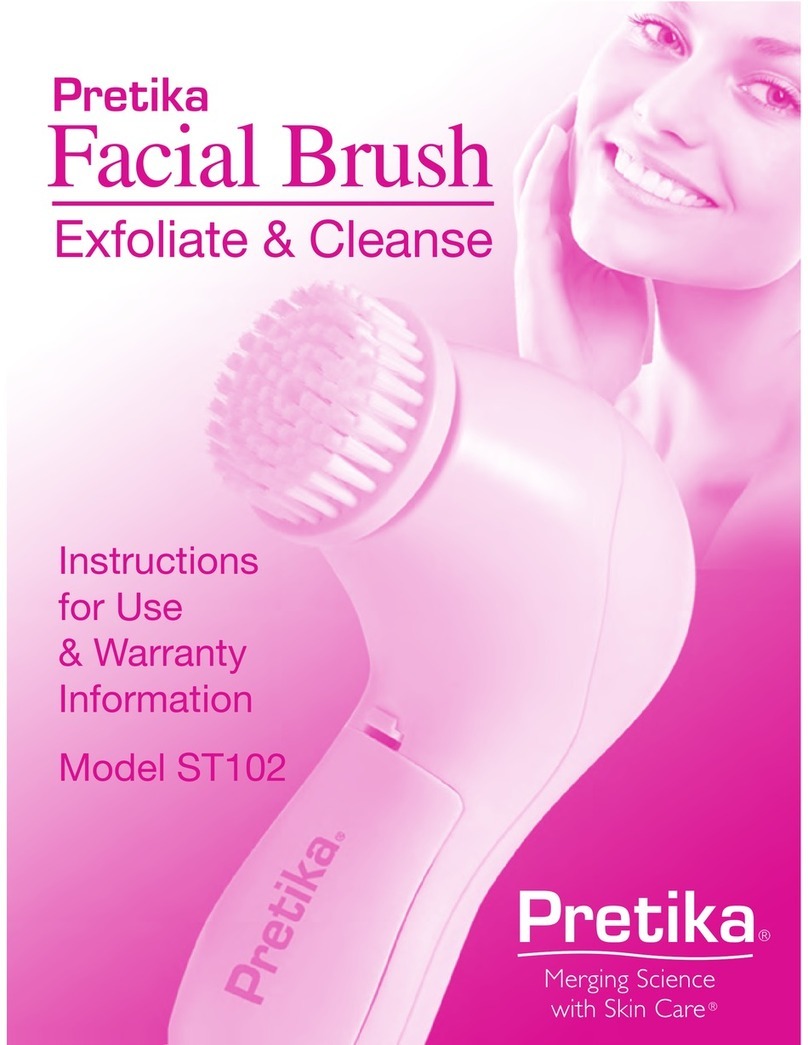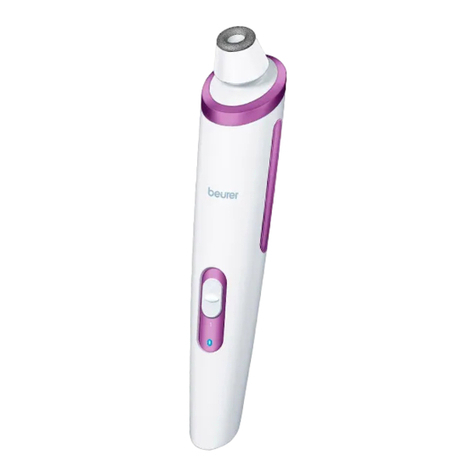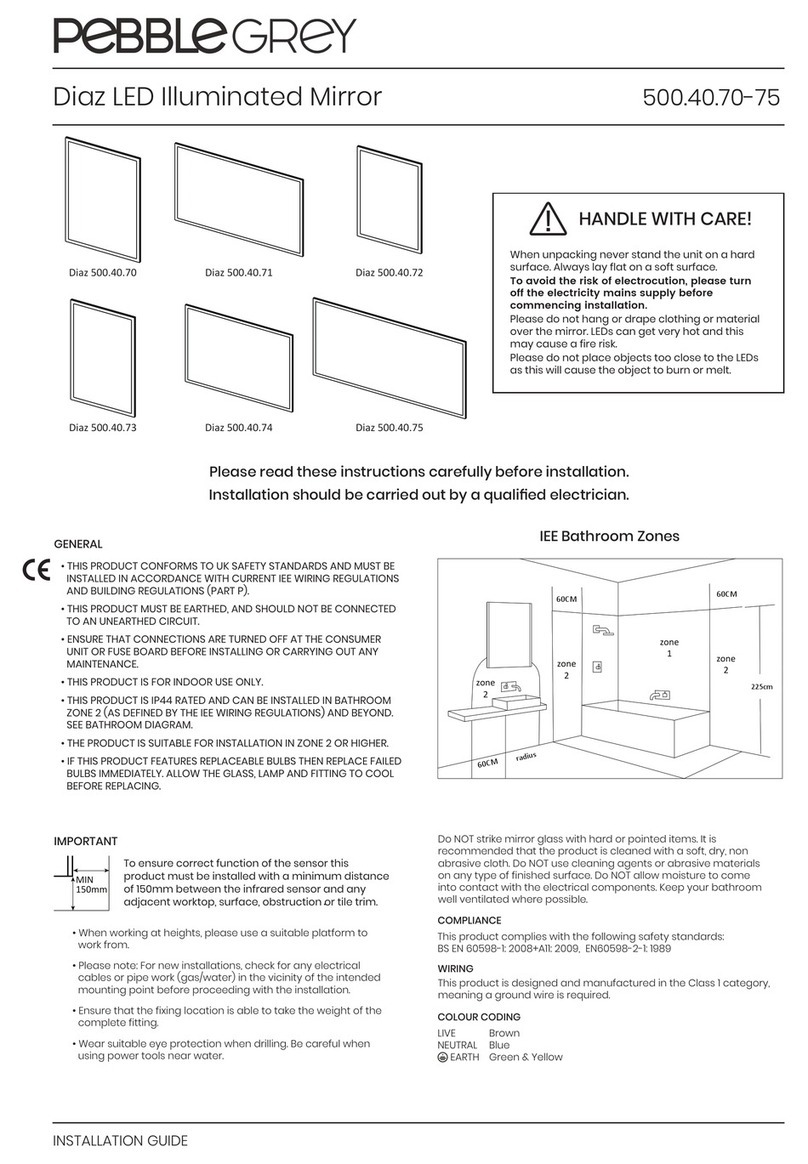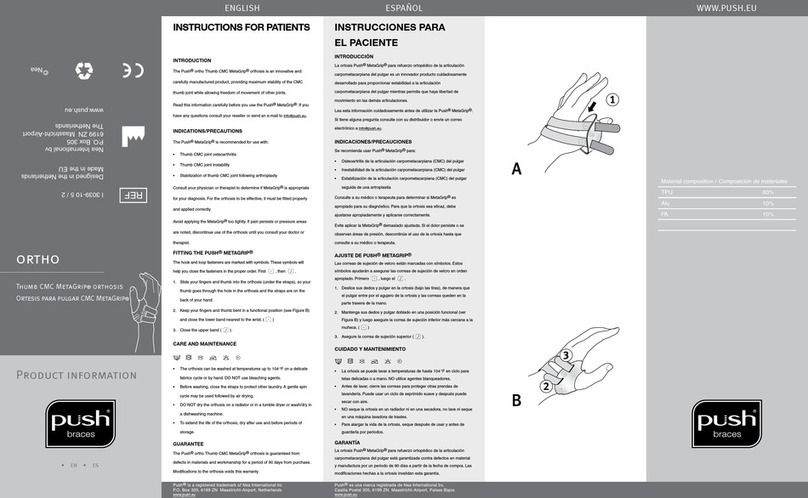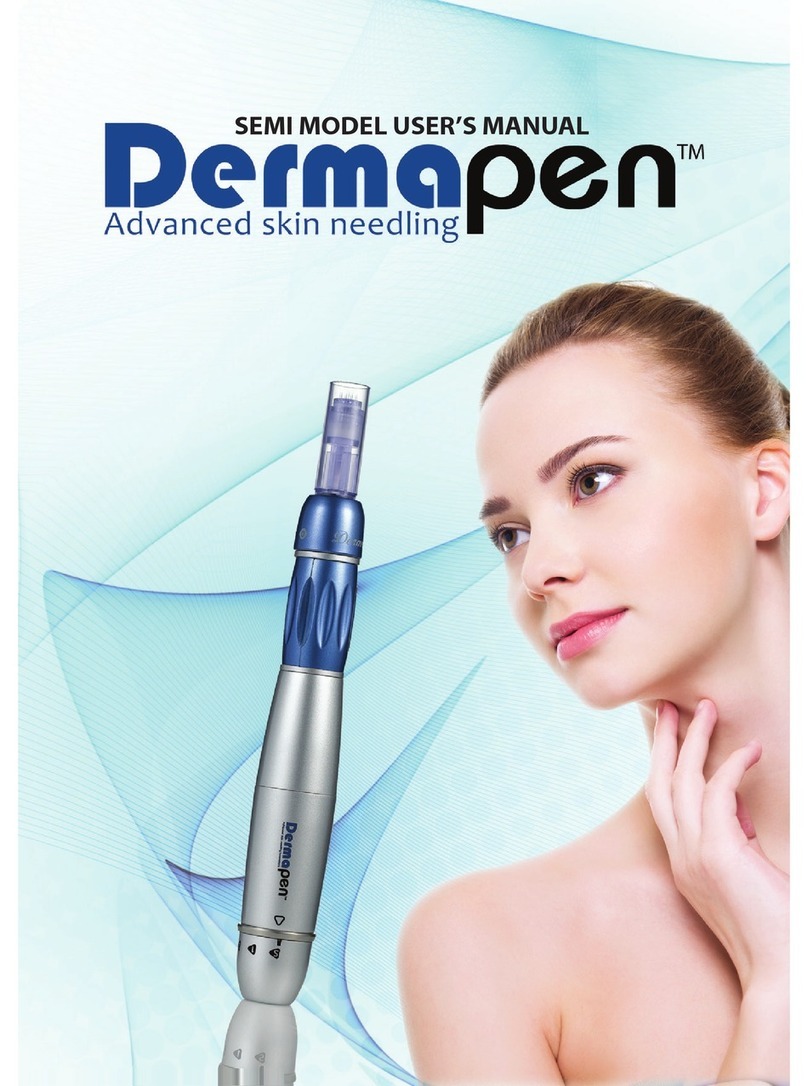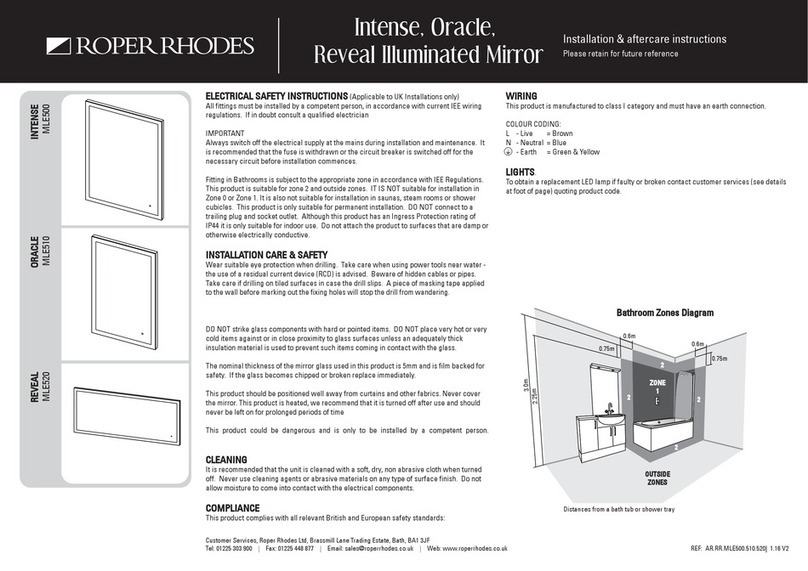EFBE-SCHOTT SC OKB 920 D User manual

Upper body tanner
With digital control panel and LED display
Oberkörpersolarium
Digitale Bedienung mit LED-Display
Bronzeur pour le haut du corps
Avec panneau de contrôle digital et écran LED
Bronceador para la parte superior
del cuerpo
Con panel de control digital y pantalla LED
Solarium dla górnej części ciała
Z cyfrowym panelem sterowania i wyświetlaczem LED
Bovenlichaambruiner
Met digitale bediening en LED-scherm
SC OKB 920 D
230V~ 50Hz 440W
I/B Version
220412

2

3
TABLE OF CONTENTS –INHALTSVERZEICHNIS –SOMMAIRE
TABLA DE CONTENIDO –SPIS TREŚCI –INHOUDSOPGAVE
ENGLISH
Parts description ……………………………. 4
Important safeguards .........................…... 6
Skin tanning introduction ........................ 10
Tanning plan …......................................... 11
Scope of delivery and packaging ......... 12
Operation ................................................. 12
Cleaning and care .................................. 13
DEUTSCH
Teilbeschreibung ……………...…………… 4
Wichtige Sicherheitsvorschriften …...….. 15
Wissenswertes über Hautbräunung ....... 19
Planung von Bräunungssitzungen .......... 20
Lieferumfang und Verpackung .............. 21
Bedienung ................................................ 21
Reinigung und Pflege ............................. 22
FRANÇAIS
Description des parties ……………………. 4
Consignes de sécurité ......................…... 25
Introduction au bronzage ...................... 29
Plan des séances de bronzage …......... 30
Contenu de la boîte et emballage ........ 31
Utilisation ................................................... 31
Nettoyage et entretien ........................... 32
ESPAÑOL
Descripción de las partes .......................... 4
Consejos de seguridad ........................... 35
Introducción al bronceado de la
piel ............................................................ 39
Plan de bronceado ................................. 40
Entrega y embalaje …………………....... 41
Funcionamiento ...................................... 41
Limpieza y cuidados ................................ 42
POLSKI
Opis części .................................................. 4
Instrukcje bezpieczeństwa ..................... 45
Opalanie skóry –wstęp .......................... 49
Plan naświetlań ….................................... 50
Zakres dostawy i zawartość
opakowania ............................................. 51
Użytkowanie ............................................. 51
Czyszczenie i pielęgnacja ....................... 52
NEDERLANDS
Onderdelenbeschrijving ........................... 4
Belangrijke veiligheidsvoorschriften ....... 55
Introductie over het bruinen van de
huid ........................................................... 59
Bruiningsschema ...................................... 60
Leveringsomvang en verpakking ........... 61
Gebruik ...................................................... 61
Reiniging en onderhoud ........................ 62

4
PARTS DESCRIPTION –TEILBESCHREIBUNG –DESCRIPTION DES PARTIES
DESCRIPCIÓN DE LAS PARTES –OPIS CZĘŚCI
ONDERDELENBESCHRIJVING
ENGLISH
1. Filter screen
2. On/Off Buttons
3. Display screen
4. Carry handle
5. Cable storage compartment
6. « User » button
7. « Up » and « down » buttons
8. User display
9. Timer display
DEUTSCH
1. Filterscheibe
2. Ein-/Aus-Taste
3. Digitaler Bildschirm
4. Tragegriff
5. Kabelfach
6. « Benutzer »-Taste
7. « Pfeil-nach-oben »-Taste und « Pfeil-
nach-unten »-Taste
8. Anzeige Benutzer
9. Anzeige Bestrahlungszeit

5
FRANÇAIS
1. Ecran filtrant
2. Boutons Marche/Arrêt
3. Ecran d’affichage
4. Poignée de transport
5. Compartiment de rangement du
câble
6. Bouton « utilisateur »
7. Boutons « haut » et « bas »
8. Affichage de l’utilisateur
9. Affichage de la minuterie
ESPAÑOL
1. Pantalla de filtro de luz
2. Interruptor de encendido/apagado
iluminado
3. Temporizador
4. Asa de transporte
5. Compartimento para guardar el
cable
6. Botón de « usuario »
7. Botones « arriba » y « abajo »
8. Visualización de usuario
9. Visualización del temporizador
POLSKI
1. Ekran filtrowania światła
2. Podświetlany włącznik/wyłącznik
3. Zegar
4. Uchwyt do przenoszenia
5. Schowek na przewód
6. Przycisk « Użytkownik »
7. Przyciski « w górę » i « w dół »
8. Wyświetlacz użytkownika
9. Wyświetlacz timera
NEDERLANDS
1. Lichtfilterglas
2. Verlichte aan-uitschakelaar
3. Timer
4. Draaggreep
5. Snoeropbergvak
6. « Gebruiker »-knop
7. « Omhoog »- en « omlaag »-knoppen
8. Gebruikersdisplay
9. Timerdisplay

6
ENGLISH
IMPORTANT SAFEGUARDS
Please read these instructions carefully before using the
appliance, and always follow the safety and operating instructions.
Keep this manual for future reference. If the article is passed on,
this manual must also be included, as it is an essential part of the
product.
Important: This appliance can be used by children over 8 years
old and people with reduced physical, sensory or mental
capacities or with a lack of experience or knowledge if they have
been given supervision or instructions concerning the safe use of
the appliance and the risks involved. Children shall not play with
the appliance. Cleaning and user maintenance shall not be made
by children unless they are older than 8 years and supervised.
Never leave the appliance and its cord unsupervised and within
reach of children less than 8 years old or irresponsible persons,
especially when it is plugged into the wall or when it is cooling
down.
❑Only connect the device to an alternating current supply with
a voltage of 230 volts.
❑If the mains connection cable or the appliance show any signs
of damage, they must be replaced by the manufacturer, its
customer service or a qualified specialist (*) in order to avoid
any danger.
❑Make sure that the ventilation slots on the back of the device
are not covered during use.
❑Always make sure that the filter glass is intact! Tanning with a
defective filter glass can lead to severe skin burns.
❑For technical safety reasons, never let any water run into the
device and never immerse it in water.
❑Do not use the appliance near water or wet areas (e.g. in the
bathroom, near a shower or a swimming pool).
❑Do not use the appliance if the timer is defective.
❑The device is not suitable for use in potentially explosive
atmospheres.

7
❑Unplug the appliance after use.
❑Always let the device cool down before storing. (Cooling time:
15 minutes)
❑Caution: The lamp does not light when hot. Allow a cooling
time of 4 –5 minutes before using the appliance again.
❑Certain materials that fade when exposed to sunlight (e.g.
paintings) should not be exposed to the appliance’s ultraviolet
light for too long.
❑Non-users, and particularly children, must not be present when
the device is in use.
❑The duration of exposure should not exceed the personal
minimal erythema dose (MED), i.e. the minimum UV dose that
causes perceptible reddening of the skin. If erythema (redness
of the skin) occurs a few hours after a tanning session, no
further exposure should take place. After a break of one week,
the treatment can be resumed, starting from the beginning of
the tanning plan.
❑If unexpected effects, such as itching, occur within 48 hours
after the first exposure, please seek medical advice before the
further use of the device.
❑Ultraviolet radiation emitted by the sun or by electronic devices
may cause irreversible damage to your skin or eyes. This
biological effect depends on the quality and quantity of
radiation and a person’s individual skin and eye sensitivity to
ultraviolet light.
❑Overexposure can cause sunburn. Repeated overexposure to
UV rays emitted by the sun or by electronic devices can lead
to premature skin aging and an increased risk of skin cancer.
These risks increase with each exposure to UV radiation.
❑Overexposure to UV radiation can lead to inflammation of the
surface of the unprotected eye and, under certain
circumstances, even to damage of the retina. Repeated
exposure to ultraviolet light can contribute to the development
of cataracts.
❑In cases of high sensitivity or allergic reactions to UVA rays,
please seek medical advice before using the device.

8
❑This symbol identifies the product as a Class II
device.
❑Devices with this protection class use reinforced or double
insulation.
Devices emitting UV rays must not be used by:
❑persons younger than 18 years;
❑persons who tend to get freckles;
❑persons with natural red hair;
❑persons with atypical discoloured skin areas;
❑persons with more than 16 moles (2 mm in diameter or larger)
on their whole body;
❑persons with atypical moles (atypical moles are described as
asymmetric moles with a diameter greater than 5 mm and with
varying pigmentation and irregular borders);
❑persons suffering from sunburn;
❑persons who are unable to tan, or do not tan without getting
sunburnt when exposed to direct sunlight;
❑persons who tend to get sunburnt when exposed to direct
sunlight;
❑persons who repeatedly suffered from severe sunburns during
their childhood;
❑persons suffering or having suffered from skin cancer, or
having a predisposition towards skin cancer;
❑persons whose first-degree relatives have been diagnosed
with melanoma (malignant melanoma);
❑persons undergoing medical treatment for diseases associated
with photosensitivity;
❑persons who take photosensitizing drugs.

9
The following precautions must be taken when using the device:
❑Always wear the included safety goggles; contact lenses and
sunglasses are never an equivalent substitute for the safety
goggles.
❑Remove any make-up prior to the exposure; do not use
sunscreen or products that speed up tanning.
❑Certain medical conditions or side effects of drugs may be
enhanced by ultraviolet radiation; if in doubt, please seek
medical advice.
❑Allow a break of at least 48 hours between the first two tanning
sessions.
❑Never sunbathe AND use the appliance on the same day.
❑Please observe the recommendations for treatment duration,
breaks and distance to the lamps.
❑Seek medical advice if persistent swellings or sore spots
develop on the skin, or if pigmented moles start to change.
❑Always protect sensitive skin areas such as scars, tattoos and
genitals from exposure to ultraviolet light.
(*) Competent qualified service: after-sales department of the
producer or importer or any person who is qualified, approved and
competent to perform this kind of repairs in order to avoid all
danger. In case of need you should return the appliance to this
service.

10
SKIN TANNING INTRODUCTION
The sun
The sun is the source of life on earth. As we can see from the rotation of the seasons and
from our personal holiday experiences, light and warmth have a huge impact on our health
and physical well-being. A bronzed skin is generally associated with a healthy and
attractive appearance and, thus, enhances a person’s self-confidence and well-being. At
the same time, a suntan serves the biological purpose of protecting our skin from sunburn,
particularly before going on a summer holiday.
The tanning
The tanning process is stimulated by a certain part of the light spectrum, regardless of
whether the light is naturally produced by the sun or artificially produced.
Sunlight contains both a visible spectrum, which can be detected as light by the human
eye, and invisible rays, such as those we feel as heat or that can lead to reddening of the
skin or even sunburn. Rays that tan our skin belong to the spectrum of invisible ultraviolet
(UV) radiation. It consists of three components: UVA, UVB and UVC radiation.
A perfect tan requires a preferably intense amount of UVA radiation, a very low amount of
UVB and no UVC radiation at all.
UVC rays are blocked by the earth's atmosphere, while UVB and UVA rays do pass and can
tan our skin. However, the rather high amount of UVB radiation emitted by the sun might
quickly lead to excessive irritation, reddening and, hence, to sunburn in people with pale
skin.
UVA tanning devices
UVA tanning devices by efbe-Schott feature a more favourable composition of UV
radiation compared to natural sunlight. The intensity of UVA radiation is much higher than
in natural sunlight, while at the same time, the harmful UVB radiation has been reduced to
a fraction of the amount that is present in natural sunlight. In comparison to natural sunlight,
the tanning process is usually accelerated while there is normally no risk of sunburn. The
tanning colour that can be obtained is similar to a natural suntan.
However, the skin’s reaction to sun rays varies from one individual to another.
Skin types and exposure times
Each of us knows their skin’s individual tanning behaviour when exposed to direct sunlight.
Thus, a similar reaction of our skin may be expected from exposure to artificial UV light.
People who can tolerate the sun very well tend to tan more quickly, while those who are
unable to tan in the sun have only little chance of success when using UVA tanning devices.
Classification of skin types according to the reaction of the skin that has not been pre-
irradiated to natural sunlight :
Skin type
Skin reaction and ethnicity
I
Always get sunburned quickly, hardly or no tan, even after repeated
irradiations (Celtic type)
II
Almost always sunburn, moderate tan after repeated exposures (fair-
skinned type)
III
Moderately often sunburn, progressive tanning after repeated irradiations
(dark-skinned type)
IV
Rarely sunburn, rapid onset and clear tan (Mediterranean type)

11
Be careful when determining your individual exposure time, always taking into account
your personal suntan experience.
Using a tanning device is only recommended for people with skin types II, III and IV.
People with skin type I and children younger than 14 years are not able to tan, neither in
natural sunlight nor when using a tanning device.
Depending on your skin type, the following tanning-session sequence is recommended
when using the tanning device:
OKB 920 D - distance from the device: 120 cm
TANNING PLAN
Skin type
II
III
IV
Exposure
Two exposures
per week
13
18
23
min.
Exposure
15
21
27
min.
Exposure
17
24
31
min.
Exposure
19
27
34
min.
Exposure
21
29
38
min.
Exposure
23
32
41
min.
Exposure
25
35
45
min.
Exposure
27
38
49
min.
Exposure
29
40
52
min.
Afterwards:
2 exposures per week, each max.
33
46.5
59
min.
Max. number of exposures per year
60
43
33
Or:
3 exposures per week, each max.
22
31
39
min.
Max. number of exposures per year
90
64
50
The following base values have been used:
Skin type
II
III
IV
Initial dose
100
140
180
Annual dose
15 kJ/m²
Final dose
250
350
450
If you feel the recommended exposure time is too long (particularly when your skin
becomes very tight and sensitive), please reduce the exposure time, for instance by 25%
or more.

12
SCOPE OF DELIVERY AND PACKAGING
First, check if the packaging is undamaged and complete. If any parts are missing, do not
use the device, but contact your retailer or service centre.
Package Contents
•The device
•Safety goggles
•Instruction book
Packaging
The packaging is made of environmentally friendly raw materials. It is reusable or can be
returned to the raw material cycle. Properly dispose of unused packaging material.
Immediately report any shipping damage to the retailer.
Always keep packaging films out of the reach of children. There is a risk of suffocation!
OPERATION
Switch-on
•Connect the tanning device to the mains supply. The display lights up briefly and
emits an acoustic signal before turning off automatically.
•Press the On/Off button to light up the display, the field "USER" will flash.
•Press the User button, the number "13" will flash: this is the recommended exposure
time of 13 minutes for the first exposure for skin type II users, as mentioned in the
tanning-session plan.
•By pressing the User button again, the user display advances by one user.
The settings allow a maximum of 8 different users. If a user is selected again, the
exposure time of their previous tanning session will flash.
•By pressing the “Up”button, you can increase the exposure time by 1 minute.
The maximum exposure time is 60 minutes.
•By pressing the “Down” button, you can reduce the exposure time by 1 minute.
The minimum exposure time is 1 minute.
•Press the On/Off button again to switch on the UVA lamp.
Note: If you do not press the On/Off button to switch on the UVA lamp within 5
minutes after setting the exposure time, the device will switch off automatically and
the previously set time will not be saved.
•Once the timer has elapsed, the device switches off automatically.
You can also switch off the device at any time by pressing the On/Off button.
•Do not exceed the recommended exposure time!
•Never continuously expose to UV radiation!
Components and controls
The UVA lamp does not light when hot. For physical reasons, the UVA lamp requires a
starting and cooling time of approx. 5 minutes.
Exposure advice
•Slightly turn your head to the left and to the right in order to ensure an even tanning.
•The device can be used for tanning your face and other body areas.
•Always wear the safety goggles during exposure to protect your eyes.

13
CLEANING AND CARE
•Always unplug the device before cleaning!
•Always make sure that the filter glass is undamaged and clean. Stains, dust and
fingerprints can burn in and reduce the efficiency of radiation.
•Clean the filter glass with a clean cloth and methylated spirits.
•If required, clean the housing of the device with a damp (not wet) sponge or cloth.
Repairs
•The filter glass has specially adapted filter characteristics and must be replaced by
an original filter glass when damaged.
•We are not liable for glass breakage even in the case of a new device, nor for any
transport damage to repair devices that have been sent in with inadequate
packaging.
•We recommend to keep all parts of the original packaging.
•Any repairs, including the replacement of the power cord, may only be carried out
by the manufacturer, its customer service or a similarly qualified technician in order
to avoid any hazards.
Replacement lamp for the tanning device
OKB 920 D: reference of the replacement lamp : HPA 400/30 S IV
Like all fluorescent tubes, radiation lamps contain specific admixtures. Defective radiation
lamps are classed as hazardous waste and must not be disposed of in the household
waste.
PROTECTION OF THE ENVIRONMENT –DIRECTIVE 2002/96/EC
In order to preserve our environment and protect human health, the waste electrical and
electronic equipment should be disposed of in accordance with specific rules with the
implication of both suppliers and users. For this reason, as indicated by the symbol
on the rating label or on the packaging, your appliance should not be disposed of as
unsorted municipal waste. The user has the right to bring it to a municipal collection point
performing waste recovery by means of reuse, recycling or use for other applications in
accordance with the directive.
ERP DECLARATION –REGULATION 1275/2008/EC
We, Efbe Elektrogeräte GmbH, hereby confirm that our product meets the requirements
of Regulation 1275/2008/EC. Admittedly, our product does not dispose of a function to
minimize the power consumption, which should according to Regulation 1275/2008/EC
put the product in off or standby mode after finishing the main function, but this is
practically impossible, as it would compromise the main function of the product so
strongly, that using the product would no longer be possible!
For this reason, we always tell the customer in our instruction manual to unplug the
appliance immediately after use.

14
DECLARATION OF CONFORMITY
We guarantee the conformity of the product with the legally prescribed standards. The
complete declaration of conformity can be requested from our address below:
Efbe Elektrogeräte GmbH, Gustav-Töpfer-Str. 6, 07422 Bad Blankenburg, Germany
The instruction manual is by simple request also available in electronic format from the
after-sales service (see warranty card).
WARRANTY AND GUARANTEE CONDITIONS
The legal provisions for warranty claims apply to our products. Within this warranty period, we
will remedy any defects based on material or manufacturing errors. Excluded from this are
damage to fragile parts, damage caused by excessive stress, improper handling and
maintenance, non-observance of the instructions for use, and damage caused by wear
and tear or as a result of normal wear and tear. In addition to this, the warranty expires in
case of intervention by third parties. In this case, the seller shall not assume any liability in the
event of damage.
If you notice any defect, please return the entire device to your retailer or sales outlet.
Warranty claims only apply in connection with the related receipt or a copy of a repair
invoice, which has/have to be submitted when using this service.
You can also send in the cleaned device with a short, easy-to-read error description and the
receipt in a prepaid parcel to our company’s customer service in Bad Blankenburg,
Germany.
After expiry of the legal warranty period
Repairs can be carried out by appropriate specialists or a repair service, but repair charges
apply in this case. Contact our delivery of spare parts and customer service.

15
DEUTSCH
WICHTIGE SICHERHEITSVORSCHRIFTEN
Lesen Sie aufmerksam die Gebrauchsanleitung, bevor Sie Ihr
Gerät benutzen, und befolgen Sie immer die
Sicherheitsvorschriften und die Gebrauchsanweisung. Bewahren
Sie diese Anleitung zum späteren Nachlesen auf. Bei Weitergabe
des Artikels ist auch diese Anleitung mitzugeben, da sie ein
wesentlicher Bestandteil des Produktes ist.
Wichtig: Das Gerät kann von Kindern ab 8 Jahren und von
Personen mit einer körperlichen, sensorischen, geistigen oder
motorischen Behinderung oder einem Mangel an Erfahrung und
Kenntnissen verwendet werden, sofern diese Personen
beaufsichtigt oder über den sicheren Gebrauch des Geräts
unterrichtet wurden und die damit verbundenen Gefahren
verstanden haben. Kinder dürfen nicht mit dem Gerät spielen.
Reinigung und Benutzer-Wartung dürfen nicht durch Kinder
durchgeführt werden, es sei denn, sie sind älter als 8 Jahre und
beaufsichtigt. Lassen Sie Ihr Gerät und dessen Netzkabel nie
unbeaufsichtigt und inReichweite von Kindern unter 8 Jahren oder
unverantwortlichen Personen, während es an der Steckdose
angeschlossen ist oder abkühlt.
❑Das Gerät nur an Wechselstrom mit einer Spannung von 230
Volt anschließen.
❑Weist die Netzanschlussleitung Beschädigungen auf,
muss sie vom Hersteller, seinem Kundendienst oder
einer qualifizierten Fachkraft ersetzt werden, um eine
mögliche Gefährdung auszuschließen.
❑Weisen die Netzanschlussleitung, das Netzteil oder der
Controller Beschädigungen auf, müssen sie vom Hersteller,
seinem Kundendienst oder einer qualifizierten Fachkraft (*)
ersetzt werden, um eine mögliche Gefährdung
auszuschließen.
❑Aus Gründen der technischen Sicherheit das Gerät nie mit
Wasser behandeln oder in Wasser tauchen.

16
❑Achten Sie darauf, dass die Lüftungsschlitze auf der
Rückseite des Geräts während der Verwendung nicht
abgedeckt sind.
❑Immer auf eine intakte Filterscheibe achten! Eine Bestrahlung
mit defekter Filterscheibe kann starke Hautverbrennungen zur
Folge haben.
❑Gerät nicht in der Nähe von Wasser benutzen (z. B. im
Badezimmer, in der Nähe der Dusche oder eines
Schwimmbeckens).
❑Wenn die Schaltuhr fehlerhaft ist, darf das Gerät nicht
verwendet werden.
❑Das Gerät ist nicht für den Gebrauch in explosionsgefährdeten
Räumen geeignet.
❑Nach Gebrauch Netzstecker ziehen.
❑Nur das abgekühlte Gerät zur Aufbewahrung wegstellen.
(Abkühlzeit: 15 Minuten)
❑Achtung: Die Lampe zündet nicht im heißen Zustand. Halten
Sie vor einer erneuten Inbetriebnahme eine Abkühlzeit von 4 –
5 Minuten ein.
❑Gewisse Materialien, die bei Sonnenbestrahlung verblassen
(z. B. Gemälde) sollten auch dem UV-Licht des Geräts nicht zu
lange ausgesetzt werden.
❑Wenn das Gerät betrieben wird, dürfen Nichtanwender,
insbesondere Kinder, nicht anwesend sein.
❑Die Bestrahlungen sollten nicht die persönliche minimale
Erythem Dosis (MED) überschreiten, also die minimale UV-
Dosis, die die wahrnehmbare Rötung der Haut hervorruft. Falls
ein Erythem (Hautrötung) Stunden nach einer Bestrahlung
auftritt, sollten keine weiteren Bestrahlungen stattfinden. Nach
einer Woche können die Bestrahlungen ab Anfang des
Bestrahlungsplanes wieder aufgenommen werden.
❑Bei Auftreten unerwarteter Effekte, wie beispielsweise Jucken
innerhalb von 48 h nach der ersten Bestrahlung, sollte vor
weiteren Bestrahlungen der Arzt um Rat gefragt werden.
❑In Fällen besonderer individueller Empfindlichkeit oder
allergischer Reaktionen gegen UVA-Bestrahlung sollte vor der
Bestrahlung der Arzt um Rat gefragt werden.

17
❑Ultraviolette Strahlung der Sonne oder von UV-Geräten kann
irreversible Haut- oder Augenschäden hervorrufen. Diese
biologische Wirkung hängt sowohl von der Qualität als auch
von der der Quantität der Strahlung wie auch von der
individuellen Haut- und Augenempfindlichkeit ab.
❑Die Haut kann nach übermäßiger Bestrahlung mit einem
Sonnenbrand reagieren. Wiederholte übermäßige Bestrahlung
mit UV-Strahlung von Sonne oder UV-Geräten kann zu
frühzeitiger Alterung der Haut und auch zu einem erhöhten
Risiko von Hautkrebs führen. Diese Risiken nehmen mit
zunehmender UV-Bestrahlung zu.
❑Das ungeschützte Auge kann sich auf der Oberfläche
entzünden und in bestimmten Fällen kann übermäßige
Bestrahlung die Netzhaut schädigen. Nach vielen wiederholten
Bestrahlungen kann sich eine Linsentrübung bilden.
Folgende Vorsichtsmaßnahmen müssen ergriffen werden:
❑Stets die mitgelieferte Schutzbrille verwenden; Kontaktlinsen
und Sonnenbrillen sind kein Ersatz für die Schutzbrille;
❑Kosmetika rechtzeitig vor der Bestrahlung entfernen und
keinerlei Sonnenschutzmittel oder Produkte verwenden, die
die Bräunung beschleunigen;
❑Bestimmte medizinische Bedingungen oder Nebeneffekte von
Medikamenten können durch ultraviolette Bestrahlung
verstärkt werden; im Zweifelsfalle den Arzt um Rat fragen;
❑Mindestens 48 h zwischen den ersten beiden Bestrahlungen
verstreichen lassen;
❑Nicht am gleichen Tag sonnenbaden und zusätzlich das Gerät
benutzen;
❑Den Empfehlungen bezüglich Bestrahlungsdauer,
Bestrahlungspausen und Abstand zu den Lampen folgen;
❑Einen Arzt aufsuchen, wenn sich hartnäckige Schwellungen
oder wunde Stellen auf der Haut bilden oder pigmentierte
Leberflecken sich verändern;
❑Empfindliche Hautstellen wie Narben, Tätowierungen und
Geschlechtsteile vor der Bestrahlung schützen.

18
UV-Geräte dürfen nicht benutzt werden von Personen:
❑unter 18 Jahren;
❑die dazu neigen, Sommersprossen zu bekommen;
❑mit natürlicher roter Haarfarbe;
❑mit atypisch entfärbten Hautbereichen;
❑die mehr als 16 Leberflecken (2 mm oder größer im
Durchmesser) am Körper haben;
❑die atypischen Leberflecken haben (Atypische Leberflecken
werden beschrieben als asymmetrische Leberflecken mit
einem Durchmesser größer als 5 mm mit unterschiedlicher
Pigmentierung und unregelmäßigen Grenzen.);
❑die unter Sonnenbrand leiden;
❑die überhaupt nicht bräunen können, oder nicht bräunen
können, ohne einen Sonnenbrand zu bekommen, wenn sieder
Sonne ausgesetzt sind;
❑die leicht einen Sonnenbrand bekommen, wenn sie der Sonne
ausgesetzt sind;
❑die eine Historie von wiederholten schweren Sonnenbränden
während ihrer Kindheit hatten;
❑die unter Hautkrebs leiden oder litten oder dafür prädisponiert
sind;
❑bei deren Verwandtschaft ersten Grades schwarzer Hautkrebs
(Melanom) aufgetreten ist;
❑die sich wegen Leiden, die mit Fotosensibilität einhergehen, in
ärztlicher Behandlung befinden;
❑die fotosensibilisierende Medikamente erhalten.
❑Dieses Symbol kennzeichnet das Produkt als Gerät der
Schutzklasse II.
❑Geräte mit dieser Schutzklasse verfügen über eine verstärkte
oder eine doppelte Isolierung
(*) Fachmann: anerkannter Kundendienst des Lieferanten oder
des Importeurs, der für derartige Reparaturen zuständig ist. Für
eventuelle Reparaturen wenden Sie sich bitte an diesen
Kundendienst.

19
WISSENSWERTES ÜBER HAUTBRÄUNUNG
Die Sonne
Die Sonne ist die Quelle des Lebens auf dem Planeten Erde. Das Licht und die Wärme der
Sonne haben –wie jeder vom Wechsel der Jahreszeiten und aus eigenen
Urlaubserfahrungen weiß –großen Einfluss auf unsere Gesundheit und unser körperliches
Wohlbefinden. Die Bräunung der Haut steigert durch ein gesundes, attraktives Äußeres das
natürliche Selbstbewusstsein und das persönliche Wohlbefinden. Zugleich erfüllt die Bräune
ihren biologischen Sinn, die Haut vor Sonnenbrand zu schützen –z. B. vor einem
Sonnenurlaub.
Das Bräunen
Das Bräunen geschieht durch einen bestimmten Anteil des Lichtspektrums, gleichgültig, ob
das Licht ganz natürlich durch die Sonne oder künstlich erzeugt wird.
Die Sonnenstrahlung enthält einen sichtbaren Anteil, den wir als Licht wahrnehmen, und
unsichtbare Strahlen, die wir z. B. als Wärme spüren, sowie solche Strahlen, die unsere Haut
röten oder gar verbrennen können.
Strahlen, die die Haut bräunen, liegen im Bereich der unsichtbaren Ultraviolett-(UV)
Strahlung. Dieser wird unterteilt in UVA-, UVB- und UVC-Strahlung.
Für eine optimale Bräunung ist möglichst intensive UVA-Strahlung bei einem gleichzeitig
sehr geringen Anteil UVB- und keiner UVC-Strahlung erwünscht.
Die UVC-Strahlen der Sonne werden von der Erdatmosphäre abgehalten, während die
UVB- und die UVA-Strahlen die Haut bräunen können. Der relativ hohe UVB-Anteil der
Sonnenstrahlung verursacht jedoch bei blasser Haut sehr rasch eine übermäßige Reizung,
Rötung und schließlich Sonnenbrand.
UVA-Bräunungsgeräte
Die UVA-Bräunungsgeräte von efbe-Schott zeichnen sich im Gegensatz zu natürlichem
Sonnenlicht durch eine günstigere Zusammensetzung der Strahlenanteile UVA zu UVB aus.
Die Intensität der bräunenden UVA-Strahlung ist weit höher als im Sonnenschein, und
zugleich ist der schädliche UVB-Anteil auf einen Bruchteil des Sonnenanteils
herabgemindert. Im Vergleich zur natürlichen Sonne wird man im Normalfall schneller und
ohne Sonnenbrand braun. Die erreichbare Hauttönung ist ähnlich wie bei der natürlichen
Sonne.
Die Reaktion der Haut auf Sonnenstrahlen ist jedoch bei jedem Menschen individuell
verschieden.
Hauttypen und Bestrahlungszeiten
Jeder hat Erfahrungen bezüglich des Bräunungsverhaltens seiner Haut bei direkter
Sonneneinstrahlung. Entsprechend ist die zu erwartende Reaktion der Haut bei künstlicher
Bestrahlung. Wer viel Sonne verträgt, kann schneller bräunen und wer in der Sonne gar
nicht bräunt, hat auch bei Bestrahlung mit UVA-Bräunern weniger Aussicht auf Erfolg.

20
Einteilung der Hauttypen nach der Reaktion der nicht vorbestrahlten Haut auf natürliche
Sonnenbestrahlung :
Hauttyp
Hautreaktion und ethnische Zuordnung
I
immer schnell Sonnenbrand, kaum oder keine Bräunung, auch nach
wiederholten Bestrahlungen (keltischer Typ)
II
fast immer Sonnenbrand, mäßige Bräunung nach wiederholten
Bestrahlungen (hellhäutiger Typ)
III
mäßig oft Sonnenbrand, fortschreitende Bräunung nach wiederholten
Bestrahlungen (dunkelhäutiger Typ)
IV
Selten Sonnenbrand, schnell einsetzende und deutliche Bräunung
(mittelmeerischer Typ)
Die individuell richtige Bestrahlungsdauer sollten Sie nach sorgfältiger Überlegung unter
Berücksichtigung Ihrer Erfahrungen in der Sonne festlegen.
Die Anwendung eines Bräuners wird ausschließlich empfohlen für Personen, die sich den
Hauttypen II, III oder IV zuordnen lassen.
Menschen vom Hauttyp I und Kinder unter 14 Jahren sind nicht in der Lage, normal zu
bräunen. Dies gilt sowohl in der natürlichen Sonne als auch für künstliche Bräunung.
OKB 920 D - Bestrahlungsabstand 120 cm
PLANUNG VON BRÄUNUNGSSITZUNGEN
Hauttyp
II
III
IV
Bestrahlung
Zwei
Bestrahlungen
13
18
23
min.
Bestrahlung
15
21
27
min.
Bestrahlung
17
24
31
min.
Bestrahlung
19
27
34
min.
Bestrahlung
21
29
38
min.
Bestrahlung
23
32
41
min.
Bestrahlung
25
35
45
min.
Bestrahlung
27
38
49
min.
Bestrahlung
29
40
52
min.
Danach
2 Bestrahlungen pro Woche jeweils
max.
33
46.5
59
min.
Max. Anzahl Bestrahlungen pro Jahr
60
43
33
Table of contents
Languages:
Other EFBE-SCHOTT Personal Care Product manuals
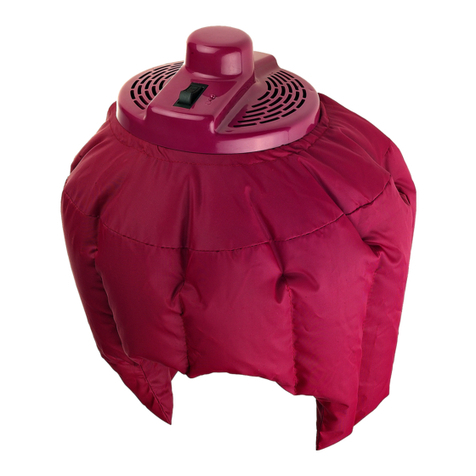
EFBE-SCHOTT
EFBE-SCHOTT LT 52 User manual

EFBE-SCHOTT
EFBE-SCHOTT SC GB 906 C User manual
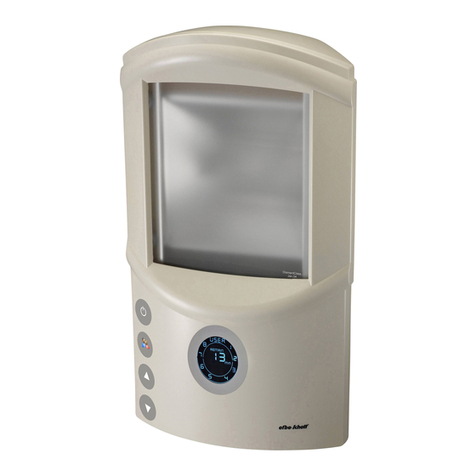
EFBE-SCHOTT
EFBE-SCHOTT OKB 912 D User manual
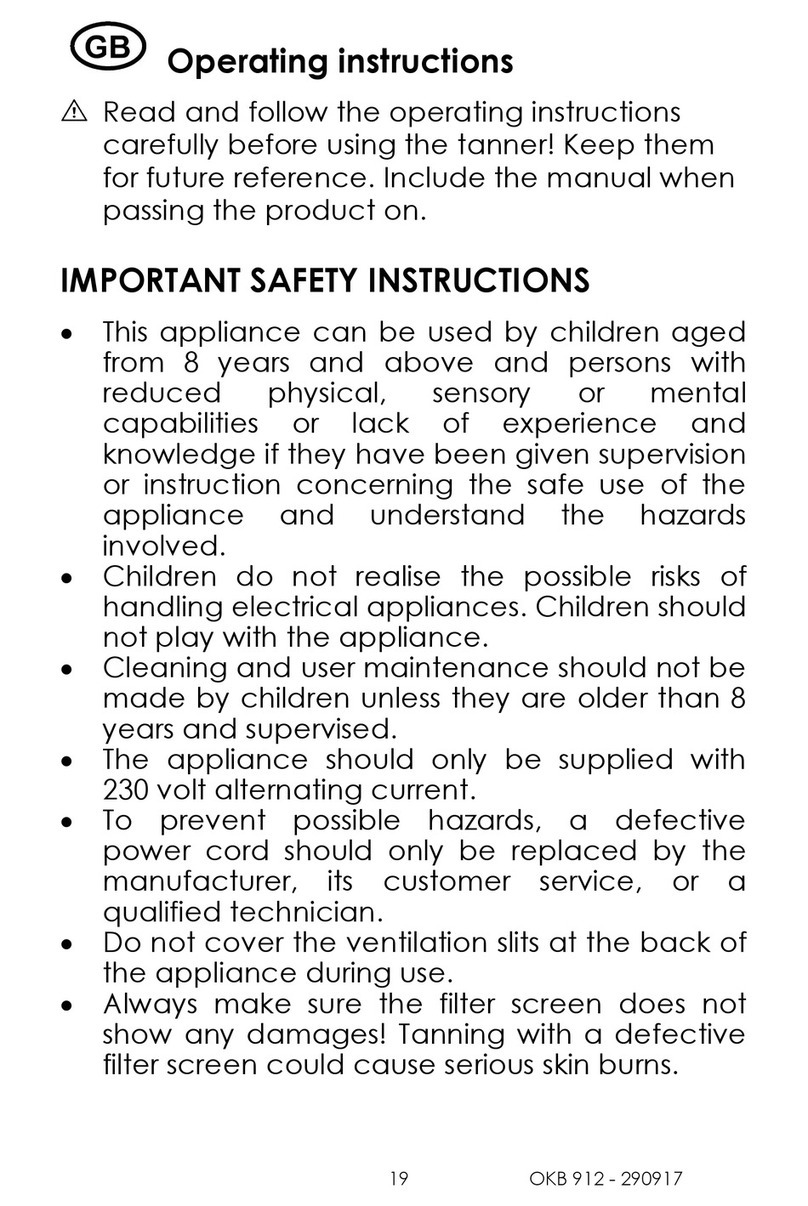
EFBE-SCHOTT
EFBE-SCHOTT OKB 912 D User manual

EFBE-SCHOTT
EFBE-SCHOTT SC GB 834 IR User manual
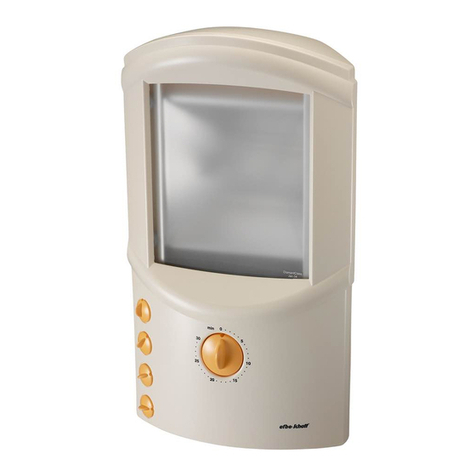
EFBE-SCHOTT
EFBE-SCHOTT SC OKB 912 User manual
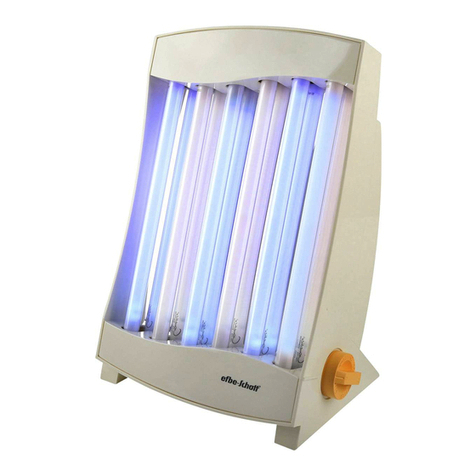
EFBE-SCHOTT
EFBE-SCHOTT SC GB 834 CN Installation instructions
